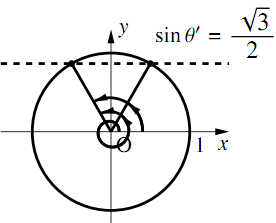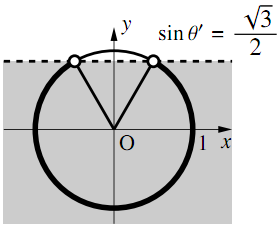三角関数の定義
三角関数の定義について
三角関数の定義について
FTEXT 数学Iで学んだ三角比(trigonometric ratio) で扱う角を任意の実数 とすれば,次の三角関数(trigonometric function) の定義となる.
三角関数の定義
無題
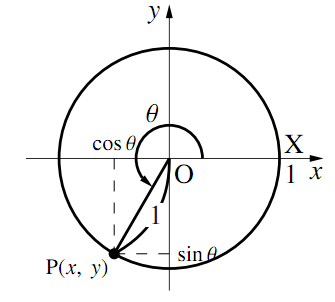
単位円周と動径の交点を$\text{P},\text{X}(1,~0)$とする.
$\angle{\text{POX}}=\theta$($\theta$は任意の実数)とするとき
$\cos\theta = $(動点$\text{P}$の$x$座標)
$\sin\theta = $(動点$\text{P}$の$y$座標)
$\tan\theta =$ (動点$\text{P}$の$y$座標)$/$(動点$\text{P}$の$x$座標)$=$(動径$\text{OP}$の傾き)
とする. ただし,動点$\text{P}$の$x$座標が$0$のとき, つまり$\theta=\dfrac{\pi}{2} +n\pi$($n$は整数) のときは$\tan\theta$は定義されない.
具体的な例で確認してみよう.
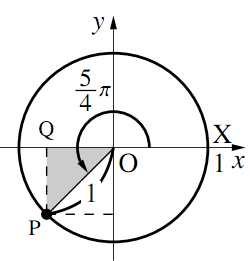
1)$\theta=\dfrac{5}{4}\pi$のとき
$\triangle{\text{OPQ}}$は$\text{PQ}:\text{QO}:\text{OP}=1:1:\sqrt{2}$の直角三角形である.つまり,$\text{P}\left(-\dfrac{\sqrt{2}}{2},~-\dfrac{\sqrt{2}}{2}\right)$なので
\begin{align} &\cos\dfrac{5}{4}\pi=-\dfrac{\sqrt{2}}{2},~~~\\ &\sin\dfrac{5}{4}\pi=-\dfrac{\sqrt{2}}{2},~~~\\ &\tan\dfrac{5}{4}\pi=1 \end{align}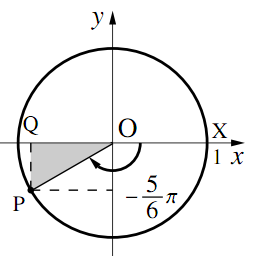
2)$\theta=-\dfrac{5}{6}\pi$のとき
$\triangle{\text{OPQ}}$は$\text{PQ}:\text{QO}:\text{OP}=1:\sqrt{3}:2$の直角三角形である.つまり,$\text{P}\left(-\dfrac{\sqrt{3}}{2},~-\dfrac{1}{2}\right)$なので
\begin{align} &\cos\left(-\dfrac{5}{6}\pi\right)=-\dfrac{\sqrt{3}}{2},~~~\\ &\sin\left(-\dfrac{5}{6}\pi\right)=-\dfrac{1}{2},~~~\\ &\tan\left(-\dfrac{5}{6}\pi\right)=\dfrac{1}{\sqrt{3}} \end{align}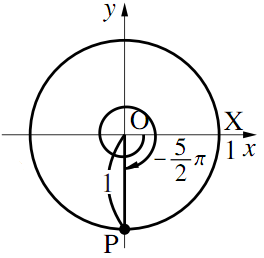
3)$\theta=-\dfrac{5}{2}\pi$のとき
$-\dfrac{5}{2}\pi=-\dfrac{1}{2}\pi -2\pi$より, $\text{X}$から負の方向へ$-\dfrac{1}{2}\pi$移動した$(0,~-1)$に$\text{P}$があるので
\begin{align} &\cos\left(-\dfrac{5}{2}\pi\right)=0,~\\ &\sin\left(-\dfrac{5}{2}\pi\right)=-1,~\\ &\tan\left(-\dfrac{5}{2}\pi\right) \end{align} は定義できない$\tan\theta$には次のような意味もあることを理解しておこう.
$\tan\theta$の図形的意味
無題
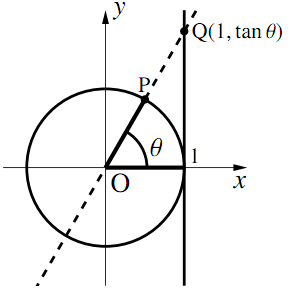
$\tan\theta$の定義は,動径$\text{OP}$の傾きであるが,傾きとは$x$軸方向に$1$増加するときの$y$軸方向の増加量である. そのため,図のように直線$\text{OP}$と直線$x = 1$の交点を$\text{Q}$とすると,$\text{Q}$の$y$座標が$\tan\theta$になる.
三角関数の定義域と値域
三角関数の定義域と値域
以上のことから,三角関数の定義域と値域は次のようにまとめられる.
三角関数の定義域と値域
三角関数の定義域
$\sin\theta,\cos\theta$の$\theta$は,任意の実数をとることができる.
$\tan\theta$の$\theta$は,$\dfrac{\pi}{2}+n\pi$($n$は整数)以外の任意の実数をとることができる.
三角関数の値域
任意の実数$\theta$に対し,$\sin\theta,\cos\theta$は$ − 1$以上$1$以下の値をとる.
$\dfrac{\pi}{2}+n\pi$($n$は整数)以外の任意の実数$\theta$に対し,$\tan\theta$は任意の実数をとる.
三角関数の符号と動径の象限
三角関数の符号と動径の象限
三角関数の値の符号は,その角の動径がどの象限に含まれるかで決定する. まとめると次のようになる.
三角関数の符号と動径の象限
三角関数の値の符号は,動径のある象限によって次のように決まる.
1)$\sin\theta$の符号
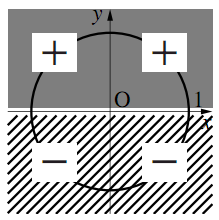
2)$\cos\theta$の符号
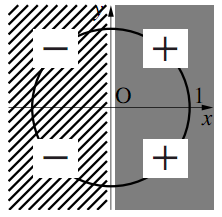
3)$\tan\theta$の符号
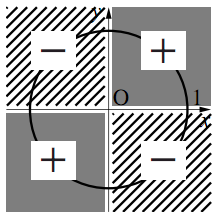
任意の角に対する三角関数の値
以下の角度に対する,正弦,余弦,正接の値をそれぞれ求めよ.
- $\dfrac{5}{3}\pi$
- $\dfrac{7}{6}\pi$
- $\dfrac{23}{3}\pi$
- $-\dfrac{15}{4}\pi$
$\text{P}~\left(\dfrac{1}{2},~-\dfrac{\sqrt{3}}{2}\right)$なので
$\boldsymbol{\cos\dfrac{5}{3}\pi=\dfrac{1}{2}}$
$\boldsymbol{\sin\dfrac{5}{3}\pi=-\dfrac{\sqrt{3}}{2}}$
$\boldsymbol{\tan\dfrac{5}{3}\pi=-\sqrt{3}}$
$\text{P}~\left(-\dfrac{\sqrt{3}}{2},~ -\dfrac12\right)$なので
$\boldsymbol{\cos\dfrac{7}{6}\pi=-\dfrac{\sqrt{3}}{2}}$
$\boldsymbol{\sin\dfrac{7}{6}\pi=-\dfrac{1}{2}}$
$\boldsymbol{\tan\dfrac{7}{6}\pi=\dfrac{\sqrt{3}}{3}}$
$\dfrac{23}{3}\pi=\dfrac{5}{3}\pi +3\cdot 2\pi$より,$\dfrac{5}{3}\pi$の三角関数に等しい.1.より
$\boldsymbol{\cos\dfrac{23}{3}\pi=\dfrac{1}{2}}$
$\boldsymbol{\sin\dfrac{23}{3}\pi=-\dfrac{\sqrt{3}}{2}}$
$\boldsymbol{\tan\dfrac{23}{3}\pi=-\sqrt{3}}$
$-\dfrac{15}{4}\pi=\dfrac{1}{4}\pi +(-2)\cdot 2\pi$より,$\dfrac{1}{4}\pi$の三角関数に等しい.よって
$\boldsymbol{\cos\left(-\dfrac{15}{4}\pi\right)=\dfrac{\sqrt{2}}{2}}$
$\boldsymbol{\sin\left(-\dfrac{15}{4}\pi\right)=\dfrac{\sqrt{2}}{2}}$
$\boldsymbol{\tan\left(-\dfrac{15}{4}\pi\right)=1}$
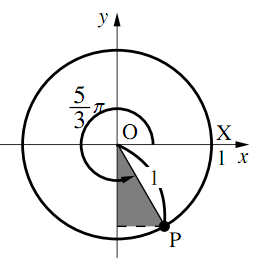
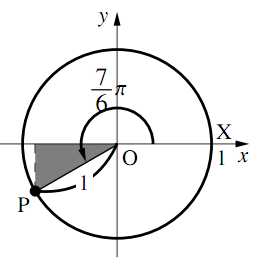
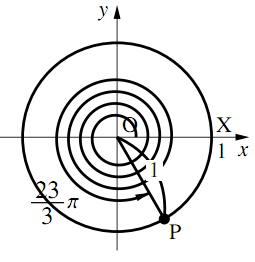
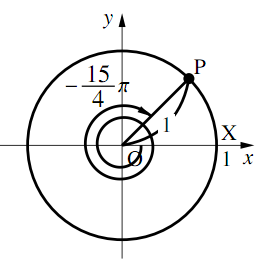
三角関数を含む方程式
- $0\leqq \theta<2\pi$のとき,$\sin\theta =-\dfrac{1}{2}$を満たす$\theta$を求めよ.
- $0\leqq \theta<4\pi$のとき,$\sin\theta =-\dfrac{1}{2}$を満たす$\theta$を求めよ.
- $\theta$を任意の実数とする.$\sin\theta =-\dfrac{1}{2}$を満たす$\theta$を求めよ.
- $-\pi\leqq \theta<\pi$のとき,$\sin\theta =-\dfrac{1}{2}$を満たす$\theta$を求めよ.
無題
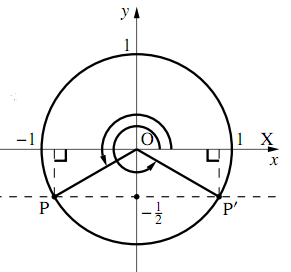
(動点の$y$座標の値)$=-\dfrac{1}{2}$であればよいので,求める$\theta$は,図の$\angle{\text{POX}},~\angle{\text{P}’\text{OX}}$に等しい.
$0\leqq \theta < 2\pi$の範囲では
$\angle{\text{POX}}=\dfrac{7}{6}\pi,~~$
$\angle{\text{P}’\text{OX}}=\dfrac{11}{6}\pi$
となる.つまり,$\boldsymbol{\theta=\dfrac{7}{6}\pi,~\dfrac{11}{6}\pi}$.
$0\leqq \theta < 4\pi$の範囲では
\begin{align} &\angle{\text{POX}}=\dfrac{7}{6}\pi,~\dfrac{7}{6}\pi +2\pi\\ &\angle{\text{P}’\text{OX}}=\dfrac{11}{6}\pi,~\dfrac{11}{6}\pi +2\pi \end{align}となる.つまり,
$\boldsymbol{\theta=\dfrac{7}{6}\pi,~\dfrac{11}{6}\pi,~\dfrac{19}{6}\pi,~\dfrac{23}{6}\pi}$.
$\theta$は任意なので,$n$を整数として
\begin{align} &\angle{\text{POX}}=\dfrac{7}{6}\pi +2n\pi,~~\\ &\angle{\text{P}’\text{OX}}=\dfrac{11}{6}\pi +2n\pi \end{align}となる.つまり,$ \boldsymbol{\theta=\dfrac{7}{6}\pi +2n\pi,~\dfrac{11}{6}\pi +2n\pi}$.
$-\pi\leqq \theta < \pi$の範囲では
\begin{align} &\angle{\text{POX}}=\dfrac{7}{6}\pi -2\pi,~~\\ &\angle{\text{P}’\text{OX}}=\dfrac{11}{6}\pi -2\pi \end{align}となる.つまり, $\boldsymbol{\theta=-\dfrac{5}{6}\pi,~ -\dfrac{1}{6}\pi}$.
三角関数を含む不等式
- $0\leqq \theta<2\pi$のとき,$\cos\theta <\dfrac{1}{2}$を満たす$\theta$の範囲を求めよ.
- $0\leqq \theta<4\pi$のとき,$\cos\theta <\dfrac{1}{2}$を満たす$\theta$の範囲を求めよ.
- $\theta$を任意の実数とする.$\cos\theta <\dfrac{1}{2}$を満たす$\theta$の範囲を求めよ.
- $-\pi\leqq \theta<\pi$のとき,$\cos\theta <\dfrac{1}{2}$を満たす$\theta$の範囲を求めよ.
無題
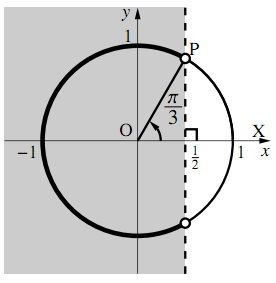
(動点の$x$座標の値)$<\dfrac{1}{2}$であればよい.
そのためには,動点が図の太線部分にあればよい.
$0\leqq \theta < 2\pi$の範囲では, $\boldsymbol{\dfrac{1}{3}\pi<\theta<\dfrac{5}{3}\pi}$.
$0\leqq \theta < 4\pi$の範囲では, 1.の答えに加えて
$\dfrac{1}{3}\pi +2\pi <\theta<\dfrac{5}{3}\pi +2\pi$
も満たすので, $\boldsymbol{\dfrac{1}{3}\pi <\theta<\dfrac{5}{3}\pi,~\dfrac{7}{3}\pi <\theta<\dfrac{11}{3}\pi}$.
$\theta$は任意なので,
$\boldsymbol{\dfrac{1}{3}\pi +2n\pi <\theta<\dfrac{5}{3}\pi +2n\pi~~}$($n$は整数)
が求める答えとなる.
$-\pi\leqq \theta < \pi$の範囲では
\begin{align} -\pi \leqq \theta<\dfrac{5}{3}\pi -2\pi,~~ \dfrac{1}{3}\pi <\theta< \pi \end{align}となる.つまり, $\boldsymbol{-\pi \leqq \theta<-\dfrac{1}{3}\pi,~ \dfrac{1}{3}\pi <\theta<\pi}$.
範囲をもつ変数の置き換え
- $0\leqq \theta <2\pi,~\theta'=2 \theta -\dfrac{\pi}{3}$とする. $\theta'$のとりうる範囲を求めよ.
- $0\leqq \theta <2\pi$のとき, 方程式$\sin\left(2 \theta -\dfrac{\pi}{3}\right) =\dfrac{\sqrt{3}}{2}$を満たす$\theta$の値を求めよ.
- $0\leqq \theta <2\pi$のとき, 不等式$\sin\left(2 \theta -\dfrac{\pi}{3}\right) <\dfrac{\sqrt{3}}{2}$を満たす$\theta$の範囲を求めよ.
-
\begin{align}
&0\leqq \theta <2\pi\\
\Leftrightarrow~&0\leqq 2\theta <4\pi\\
\Leftrightarrow~&0-\dfrac{\pi}{3} \leqq 2\theta-\dfrac{\pi}{3} <4\pi-\dfrac{\pi}{3}
\end{align}
より$\boldsymbol{-\dfrac{\pi}{3} \leqq \theta' <\dfrac{11}{3}\pi}$と分かる.
←$2$倍しても,$\dfrac{\pi}{3}$を引いても大小関係は変わらない
1.の$ \theta'$を用いると,与えられた方程式は$\sin\theta' =\dfrac{\sqrt{3}}{2}$となる. 1.より$-\dfrac{\pi}{3} \leqq \theta' <\dfrac{11}{3}\pi$なので,図より
$\theta' =\dfrac13\pi,~\dfrac23\pi,~\dfrac73\pi,~\dfrac83\pi$となる.
$\theta=\dfrac{\theta'}{2}+\dfrac{\pi}{6}$なので
\begin{align} \boldsymbol{\theta= \dfrac13\pi,~\dfrac12\pi,~\dfrac43\pi,~\dfrac32\pi} \end{align}1.の$ \theta'$を用いると,与えられた不等式は$\sin\theta' <\dfrac{\sqrt{3}}{2}$となる. 1.より$-\dfrac{\pi}{3} \leqq \theta' <\dfrac{11}{3}\pi$なので
$-\dfrac{\pi}{3}\leqq \theta' <\dfrac13\pi,~\dfrac23\pi< \theta' <\dfrac73\pi,$
$~\dfrac83\pi< \theta' <\dfrac{11}{3}\pi$となる.$ \theta'=2\theta-\dfrac{\pi}{3}$を代入して$\theta$について解けば←たとえば
\begin{align} &\dfrac{2}{3}\pi< 2\theta-\dfrac{\pi}{3} <\dfrac{7}{3}\pi\\ \Leftrightarrow~&\pi< 2\theta<\dfrac83\pi ~\Leftrightarrow~\dfrac{\pi}{2}< \theta<\dfrac{4}{3}\pi \end{align} \begin{align} &\boldsymbol{0\leqq\theta< \dfrac{\pi}{3},~\dfrac{\pi}{2}<\theta<\dfrac43\pi,}\\ &\boldsymbol{\dfrac32\pi<\theta <2\pi} \end{align}
